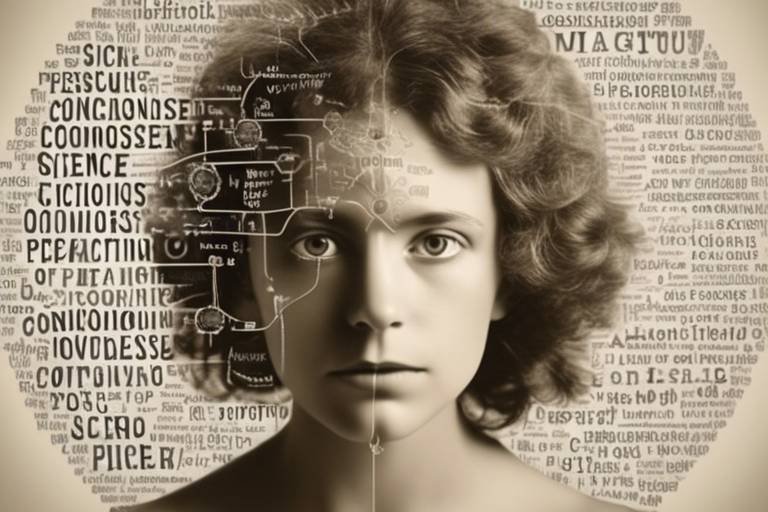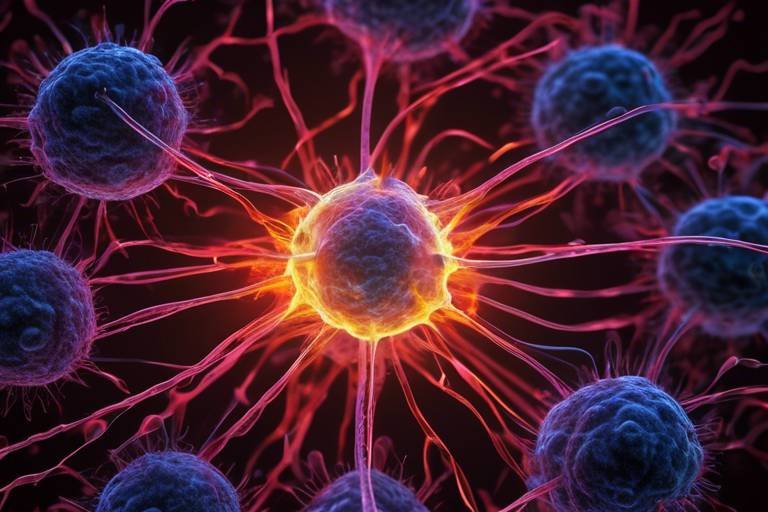Exploring the Science of Consciousness and Perception
Have you ever paused to wonder what it truly means to be aware? To experience the world around you? The intricate dance between consciousness and perception shapes our reality in ways we often take for granted. This article delves into the fascinating relationship between these two concepts, exploring how they intertwine to form our understanding of existence. From the philosophical debates that have raged for centuries to the cutting-edge research in neuroscience and psychology, we will uncover the layers of complexity that define our conscious experience.
Consciousness is not merely a passive state; it's an active engagement with our environment, a lens through which we interpret the myriad sensations that bombard us every second. Think of it as the spotlight in a theater, illuminating certain aspects of our experience while leaving others in shadow. Perception, on the other hand, is how we make sense of that light, interpreting signals from our senses to construct a coherent picture of the world. Together, they form the foundation of our reality, influencing everything from our daily decisions to our deepest beliefs.
As we journey through this exploration, we will dissect the nature of consciousness, the role of perception, and the insights offered by neuroscience. We will also touch upon the philosophical implications of subjective versus objective reality, questioning how our perceptions shape our beliefs and behaviors. Are we merely passive observers of the world, or do we actively create our reality through our conscious experiences? These questions are not just academic; they have profound implications for how we understand ourselves and our place in the universe.
So, buckle up as we embark on this intellectual adventure, peeling back the layers of consciousness and perception to reveal the astonishing intricacies of the mind. By the end, you might just see the world—and your place in it—through a whole new lens.

The Nature of Consciousness
Understanding consciousness is like peeling an onion—layer by layer, it reveals its complexity and depth. At its core, consciousness refers to our awareness of ourselves and our surroundings. But what does it really mean to be conscious? Is it merely the ability to think and feel, or is there something deeper at play? Various definitions and theories have emerged, each attempting to capture the essence of this elusive phenomenon. For instance, some argue that consciousness is a product of brain activity, while others propose that it transcends mere biological functions, hinting at a more profound existential quality.
The ongoing debates surrounding consciousness are not just academic; they have real implications for our understanding of human experience. Researchers in fields like psychology, neuroscience, and philosophy are constantly grappling with questions such as: What is the relationship between consciousness and perception? How does our conscious mind interact with the subconscious? And can we ever truly measure consciousness objectively? These inquiries lead us into a fascinating realm of exploration, where science meets philosophy.
Current research in consciousness studies often revolves around several key perspectives:
- Physicalism: This view posits that consciousness arises from physical processes in the brain, suggesting that our thoughts and feelings can be traced back to neural activity.
- Dualism: In contrast, dualists argue that the mind and body are separate entities, and consciousness cannot be fully explained by physical processes alone.
- Panpsychism: This intriguing perspective suggests that consciousness is a fundamental feature of the universe, present in varying degrees in all forms of matter.
As we delve deeper into the nature of consciousness, we find ourselves at the intersection of science and philosophy, where questions often lead to more questions. Each theory offers unique insights, but none has yet provided a comprehensive answer that satisfies all scholars. The exploration of consciousness is ongoing, fueled by advances in technology and research methodologies that allow us to probe the workings of the brain in unprecedented ways.
In conclusion, the nature of consciousness remains one of the most captivating mysteries of human existence. It invites us to ponder our place in the universe and challenges us to reconsider what it means to be aware. As we continue to explore this profound aspect of our lives, we may uncover insights that not only enhance our understanding of ourselves but also redefine our relationship with the world around us.

The Role of Perception
Perception is the lens through which we view the world, shaping our experiences and influencing our understanding of reality. It's like the software of our brain, interpreting the raw data collected by our senses and turning it into meaningful experiences. But how does this intricate process work, and why is it so crucial in our daily lives? To put it simply, perception is not just about seeing or hearing; it’s about making sense of what we encounter. It plays a significant role in how we interact with our environment, make decisions, and form beliefs.
When we talk about perception, we often think of it as a passive process, where our senses simply absorb information. However, perception is actively constructed by our brains, influenced by a myriad of factors including our past experiences, expectations, and even cultural background. Imagine walking into a bustling café. The sounds of clinking cups and chatter, the aroma of freshly brewed coffee, and the sight of people engaged in conversation all come together to create a vibrant atmosphere. Yet, how you interpret that scene can vary dramatically based on your mood, personal experiences, and even your expectations of a café experience.
One fascinating aspect of perception is its ability to filter and prioritize sensory information. Our brains are bombarded with a constant stream of data from our surroundings. To manage this overload, we rely on perceptual processes that help us focus on what’s important while ignoring the rest. For instance, when you’re having a conversation in a crowded room, your brain filters out the background noise, allowing you to concentrate on the person speaking to you. This selective attention is a powerful tool that enables us to navigate our complex environments effectively.
In addition to filtering information, perception also involves interpretation. This means that two people can experience the same event but perceive it in entirely different ways. For example, consider a piece of abstract art. One viewer might see chaos and confusion, while another perceives beauty and harmony. This subjectivity highlights how personal experiences and emotional states can shape our perceptions, leading to varied interpretations of the same stimuli.
Furthermore, perception can be influenced by psychological factors such as biases and stereotypes. Our preconceived notions can color how we perceive others and the world around us. For instance, if someone has a negative stereotype about a particular group of people, they might perceive individuals from that group through a biased lens, affecting their interactions and relationships. This demonstrates that perception is not just a straightforward process; it is deeply intertwined with our beliefs, emotions, and social contexts.
In essence, perception is a complex interplay of sensory input, cognitive processes, and emotional responses. It shapes our reality in profound ways, influencing everything from our daily choices to our long-term beliefs. As we continue to explore the science of perception, it becomes increasingly clear that understanding this process is crucial not only for psychology and neuroscience but also for improving our interpersonal relationships and enhancing our overall quality of life.
- What is perception?
Perception is the process by which our brains interpret sensory information to create a meaningful understanding of our surroundings.
- How does perception influence our experiences?
Perception shapes our experiences by determining how we interpret and respond to sensory information, affecting our emotions and decisions.
- Can perception be biased?
Yes, perception can be influenced by biases, stereotypes, and personal experiences, leading to subjective interpretations of the same event.

Types of Perception
When we talk about perception, it's like opening a Pandora's box filled with various ways we interpret the world around us. Perception is not a one-size-fits-all experience; instead, it encompasses a range of sensory modalities that contribute to our understanding of reality. Each type of perception—whether it be visual, auditory, or tactile—plays a unique role in how we interact with our environment and process information. Imagine walking through a vibrant forest: the colors of the leaves, the sounds of birds chirping, and the texture of the bark under your fingers all come together to create a rich tapestry of experience. This interplay of senses is what makes perception so fascinating.
Visual perception is perhaps the most dominant form of perception. Our eyes are constantly receiving light, which our brain interprets to form images. This process is not as straightforward as it seems; for instance, our brains can be tricked by optical illusions, leading us to see things that aren't really there or misinterpret the size and distance of objects. This phenomenon demonstrates how our visual perception can be influenced by context and prior experiences. For example, a familiar landmark may appear smaller or larger depending on our distance from it, showcasing the brain's incredible ability to adapt and interpret visual cues.
Then we have auditory perception, which is equally crucial in shaping our experiences. Sound waves travel through the air and are captured by our ears, where they are transformed into signals that our brains can understand. This type of perception allows us to communicate, enjoy music, and even recognize danger. Think about the last time you heard a siren blaring in the distance; your brain immediately processed that sound and triggered a response, whether it was to pull over or to feel a sense of urgency. The complexity of auditory perception lies in its ability to distinguish between different sounds and their meanings, making it essential for social interaction.
Tactile perception, on the other hand, engages our sense of touch. This type of perception allows us to feel textures, temperatures, and even pain. Consider the sensation of running your fingers over a soft blanket versus a rough piece of sandpaper. The brain processes these tactile inputs to inform us not only about the physical properties of objects but also about our emotional responses to them. For example, a warm hug can evoke feelings of comfort and safety, while a sharp object can trigger a reflexive withdrawal.
In summary, the types of perception work together to create a comprehensive understanding of our surroundings. Visual, auditory, and tactile perceptions are just the tip of the iceberg when it comes to the intricate ways we experience the world. Each type contributes uniquely to our reality, forming a rich and complex narrative that defines our interactions with both people and the environment. As we continue to explore the depths of perception, we uncover not only how we perceive the world but also how our perceptions can shape our reality.
- What is the difference between perception and sensation? Perception is the process of interpreting sensory information, while sensation refers to the initial detection of stimuli by our sensory organs.
- Can perception be altered? Yes, perception can be influenced by various factors, including context, past experiences, and even cultural backgrounds.
- How do different types of perception work together? Different types of perception, such as visual, auditory, and tactile, interact to provide a holistic understanding of our environment, enriching our experiences.

Visual Perception
Visual perception is not just a passive reception of light; it's a dynamic process that allows us to interpret the world around us. Imagine walking through a vibrant forest. The colors of the leaves, the shape of the trees, and the play of light filtering through branches all contribute to your experience. Your brain takes in this information and constructs a coherent image of your surroundings. But how does this intricate process work? It involves a series of complex steps that transform raw sensory data into meaningful visual experiences.
At the core of visual perception is the eye, which captures light and sends signals to the brain. This process begins when light enters the eye through the cornea, passes through the lens, and finally reaches the retina, where photoreceptor cells convert light into electrical signals. These signals travel via the optic nerve to various areas of the brain, particularly the visual cortex, where they are processed and interpreted. This transformation is akin to a chef turning raw ingredients into a delicious dish; the ingredients (light and color) are essential, but the chef's skill (the brain's processing ability) is what creates the final product.
However, visual perception is not infallible. Our brains are influenced by various factors that can distort our perception. For instance, context plays a significant role in how we interpret what we see. The same color can appear different depending on the surrounding colors—a phenomenon known as color constancy. Furthermore, our prior experiences and expectations can shape our visual perception. If you expect to see a red apple on a table, your brain might fill in the gaps even if the apple is partially obscured. This is where the concept of perceptual set comes into play: our mental framework influences how we perceive stimuli.
To illustrate the complexity of visual perception, consider the following table that outlines key factors influencing our visual experiences:
| Factor | Description |
|---|---|
| Lighting | The intensity and direction of light can significantly alter how we perceive colors and shapes. |
| Contrast | Differences in luminance or color between objects can enhance or diminish our ability to distinguish them. |
| Movement | Our perception of stationary objects can change when they are in motion, often leading to optical illusions. |
| Attention | What we focus on can filter out other visual information, shaping our perception of reality. |
In conclusion, visual perception is a fascinating interplay of biology and psychology. It's not merely about seeing; it's about interpreting and understanding what we see. As we continue to explore this captivating field, we uncover more about how our brains work and how our perceptions shape our reality.
- What is visual perception? Visual perception is the process by which our brains interpret and make sense of the visual information received from our eyes.
- How do our brains process visual information? The brain processes visual information through a series of steps, beginning with the eye capturing light and ending with the visual cortex interpreting the signals.
- What factors can influence visual perception? Factors such as lighting, contrast, movement, and attention can significantly affect how we perceive visual stimuli.
- Can our expectations change what we see? Yes, our expectations and prior experiences can influence our visual perception, often leading us to see what we anticipate rather than what is actually there.

Auditory Perception
Auditory perception is a fascinating aspect of how we interact with the world around us. Think about it: every time you hear a bird chirping, music playing, or someone calling your name, your brain is performing an incredible feat of interpretation and understanding. This complex process starts with sound waves, which travel through the air and enter our ears. Once inside, they are transformed into electrical signals that our brain can comprehend. It’s almost like a symphony of neurons working together to create a beautiful melody of understanding!
But what exactly happens when we hear something? The journey begins at the outer ear, where sound waves are funneled into the ear canal. From there, they vibrate the eardrum, which then moves the tiny bones in the middle ear. This mechanical action amplifies the sound before it reaches the cochlea in the inner ear. Here, the vibrations are converted into nerve impulses that travel along the auditory nerve to the brain. It’s a remarkable process that happens in mere milliseconds, allowing us to respond to sounds almost instantaneously.
Interestingly, our auditory perception is not just about hearing sounds; it encompasses various elements that help us make sense of our auditory environment. For instance, we can distinguish between different pitches, volumes, and timbres, which allows us to identify a friend’s voice in a crowded room or enjoy the nuances of our favorite song. This ability to discern sounds is crucial for effective communication and social interaction.
Moreover, auditory perception is deeply intertwined with our emotions and memories. Ever noticed how a particular song can transport you back to a specific moment in your life? That’s the power of sound! Our brains associate certain sounds with experiences, creating a rich tapestry of memories that can evoke feelings of joy, nostalgia, or even sadness. This connection between sound and emotion is why music is often considered a universal language.
However, auditory perception is not without its challenges. There are instances where our perception can be distorted. For example, in noisy environments, it can be difficult to focus on a single sound, leading to misunderstandings in conversation. Additionally, conditions like tinnitus can affect how we perceive sound, causing a ringing or buzzing sensation that can be quite distracting. Understanding these challenges is essential for improving communication strategies and developing better auditory aids.
In summary, auditory perception is a complex and vital part of our sensory experience. It enables us to connect with our environment, communicate with others, and engage with the world on a deeper emotional level. As we continue to explore the intricacies of auditory processing, we gain valuable insights into not only how we hear but also how we understand and interact with the sounds that shape our reality.

Perception and Reality
Have you ever wondered how your mind shapes the world around you? The interplay between perception and reality is a fascinating topic that raises profound questions about our existence. What we perceive is not always an accurate reflection of the world itself; rather, it's a complex tapestry woven from our sensory experiences, past knowledge, and emotional states. This subjective lens through which we view reality can significantly influence our beliefs, decisions, and interactions with others.
To understand this relationship better, let’s consider an analogy: Imagine you’re watching a movie. The visuals, sounds, and emotions you experience are all part of the film, yet they don't represent reality in the same way that your everyday life does. Similarly, our perceptions are like a movie playing in our minds, crafted from sensory input and personal interpretations. The challenge lies in the fact that each individual’s “movie” can be vastly different from someone else’s, leading to unique interpretations of the same event.
One of the most intriguing aspects of perception is its subjectivity. Two people can witness the same event but perceive it in entirely different ways. For example, consider a simple scenario like a sunset. One person may find it breathtaking and calming, while another might see it as a reminder of the day’s end, evoking feelings of sadness. This divergence in perception highlights how our backgrounds, experiences, and even mood can shape our understanding of reality.
Moreover, the philosophical implications of perception and reality are profound. Are we living in an objective reality, or is everything colored by our personal perceptions? This question has been debated by philosophers for centuries. Some argue that our perceptions create a subjective reality, suggesting that what we consider “real” is merely a construction of our minds. Others maintain that an objective reality exists, independent of our perceptions, waiting to be discovered.
In exploring these themes, it’s essential to recognize how our perceptions can lead to cognitive biases—systematic patterns of deviation from norm or rationality in judgment. These biases can influence various aspects of our lives, from decision-making to social interactions. For instance, the confirmation bias leads individuals to favor information that confirms their existing beliefs, potentially distorting their perception of reality. Understanding these biases is crucial for fostering a more accurate view of the world.
To illustrate this further, consider the following table that summarizes common cognitive biases and their effects on perception:
| Cognitive Bias | Description | Impact on Perception |
|---|---|---|
| Confirmation Bias | The tendency to search for, interpret, and remember information that confirms one's preconceptions. | Leads to a distorted view of reality, reinforcing existing beliefs. |
| Anchoring Bias | The reliance on the first piece of information encountered when making decisions. | Can skew perception based on initial impressions, affecting judgment. |
| Availability Heuristic | Overestimating the importance of information that is readily available or recent. | May distort perception of frequency or likelihood of events. |
In conclusion, the relationship between perception and reality is anything but straightforward. Our perceptions shape our understanding of the world, but they can also mislead us. By acknowledging the subjective nature of our experiences and the cognitive biases that influence them, we can strive for a more nuanced understanding of reality. This awareness not only enhances our personal growth but also enriches our interactions with others, paving the way for deeper connections and understanding.
- What is the difference between perception and reality?
Perception refers to how we interpret sensory information, while reality is the objective state of things as they exist independently of our perceptions. - Can perception change reality?
While perception itself does not change reality, it can influence our beliefs and behaviors, which in turn can affect how we interact with the world. - How do cognitive biases affect our perception?
Cognitive biases are systematic errors in thinking that can lead to distorted perceptions, often causing us to misinterpret information or situations.

Neuroscience of Consciousness
The field of neuroscience offers a fascinating glimpse into the biological foundations of consciousness, unraveling the complex interplay between our brains and our conscious experiences. At its core, consciousness can be thought of as the state of being aware of and able to think about one's own existence, thoughts, and surroundings. But how does this awareness arise from the intricate networks of neurons firing in our brains? To answer this, researchers have identified specific brain regions that play pivotal roles in conscious experience, each contributing to the tapestry of our perception and awareness.
One of the most crucial areas in understanding consciousness is the cerebral cortex, particularly the prefrontal cortex, which is often associated with higher-order functions such as decision-making, problem-solving, and self-reflection. This region acts like a conductor in an orchestra, coordinating various neural signals to produce a cohesive experience of awareness. Additionally, the thalamus serves as a relay station, channeling sensory information to the cortex, thereby playing a vital role in how we interpret and respond to our environment.
Another key player in the neuroscience of consciousness is the default mode network (DMN). This network is active when we are at rest and not focused on the external environment, often associated with daydreaming or self-referential thoughts. Interestingly, disruptions in the DMN have been linked to various psychological conditions, including depression and anxiety, highlighting how intricately our conscious experience is tied to our brain's wiring.
To better understand the relationship between brain activity and consciousness, researchers often explore the concept of neural correlates of consciousness (NCC). These correlates refer to the specific brain states that correspond with conscious experiences. For instance, studies using functional magnetic resonance imaging (fMRI) have shown that certain patterns of brain activity are consistently associated with visual awareness. The table below summarizes some key brain regions and their associated functions in relation to consciousness:
| Brain Region | Function |
|---|---|
| Cerebral Cortex | Higher-order cognitive functions, self-awareness |
| Thalamus | Relay sensory information to the cortex |
| Default Mode Network | Self-referential thoughts, mind-wandering |
| Anterior Cingulate Cortex | Emotion regulation, decision-making |
Understanding these neural correlates not only sheds light on how we experience consciousness but also opens the door to exploring how alterations in brain function can lead to changes in consciousness. For example, during sleep or under the influence of anesthesia, consciousness can be dramatically altered, providing a unique perspective on the fragility and complexity of our conscious state. This exploration is not just a theoretical endeavor; it has profound implications for various fields, including psychology, psychiatry, and even artificial intelligence.
In conclusion, the neuroscience of consciousness is a vibrant and evolving field that seeks to decode the biological basis of one of humanity's most profound mysteries. As we delve deeper into the workings of the brain, we inch closer to answering fundamental questions about what it means to be conscious and how our perceptions shape our reality.
- What is the primary function of the cerebral cortex?
The cerebral cortex is responsible for higher-order functions such as thinking, decision-making, and self-awareness. - How does the thalamus contribute to consciousness?
The thalamus relays sensory information to the cortex, playing a crucial role in how we perceive our environment. - What is the default mode network?
The default mode network is a network of brain regions that are active when we are at rest and engaged in self-referential thoughts. - What are neural correlates of consciousness?
Neural correlates of consciousness refer to the specific brain activities associated with conscious experiences.

Brain Regions and Functions
The human brain is a complex and intricate organ that plays a pivotal role in shaping our consciousness and perception. Various brain regions are responsible for different functions, each contributing uniquely to our conscious experience. Understanding these regions can help us appreciate how we interpret the world around us and the underlying mechanisms at play.
One of the most critical areas is the prefrontal cortex, often dubbed the brain's "executive center." This region is involved in decision-making, problem-solving, and planning. Imagine it as the conductor of an orchestra, harmonizing various inputs to produce a coherent output. It helps us prioritize tasks and manage our thoughts, allowing us to navigate complex social interactions and make informed choices.
Next, we have the parietal lobe, which is essential for integrating sensory information. This region allows us to perceive our body's position in space and understand how we interact with our environment. Think of it as a GPS system, constantly updating our location and surroundings. Damage to this area can lead to difficulties in spatial awareness, which can significantly impact daily activities.
The occipital lobe is primarily responsible for visual processing. It takes the raw data from our eyes and transforms it into the images we see. Without this region, our ability to recognize faces, read text, or even navigate through a room would be severely impaired. It’s like a painter mixing colors on a palette; without the right combinations, the final artwork would be unrecognizable.
Another significant player is the temporal lobe, which houses the auditory cortex. This area is vital for processing sounds and is involved in understanding language. It allows us to enjoy music, comprehend speech, and even remember melodies. Imagine trying to have a conversation in a crowded room; the temporal lobe helps filter out the noise and focus on the voice of the person speaking to you.
Furthermore, the thalamus, often referred to as the brain's relay station, plays a crucial role in consciousness. It processes and transmits sensory information to the appropriate areas of the cortex. Think of it as a traffic director, ensuring that information flows smoothly and efficiently throughout the brain. Disruptions in thalamic function can lead to altered states of consciousness, highlighting its importance in our perceptual experiences.
To summarize, the brain is a symphony of interconnected regions, each with distinct functions that contribute to our consciousness and perception. The interplay between these areas creates a rich tapestry of experiences that shape our understanding of reality.
| Brain Region | Primary Function |
|---|---|
| Prefrontal Cortex | Decision-making, problem-solving, planning |
| Parietal Lobe | Integration of sensory information, spatial awareness |
| Occipital Lobe | Visual processing |
| Temporal Lobe | Auditory processing, language comprehension |
| Thalamus | Relay station for sensory information |
- What is the role of the prefrontal cortex?
The prefrontal cortex is involved in decision-making, problem-solving, and planning, acting as the brain's executive center. - How does the parietal lobe contribute to our perception?
The parietal lobe integrates sensory information, helping us understand our body's position in space. - Why is the occipital lobe important?
The occipital lobe is responsible for visual processing, allowing us to interpret and understand what we see. - What functions does the temporal lobe serve?
The temporal lobe processes sounds and is crucial for understanding language and remembering melodies. - What is the function of the thalamus?
The thalamus acts as a relay station for sensory information, directing it to the appropriate areas of the brain.

Neural Correlates of Consciousness
When we dive into the fascinating realm of consciousness, one of the most intriguing questions we encounter is: What exactly happens in our brains when we are conscious? The study of the neural correlates of consciousness (NCC) seeks to answer this question by identifying the specific brain activities that correspond with conscious experiences. It's like trying to find the right key to unlock a door; understanding these correlates helps us grasp how our minds engage with the world around us.
Researchers have made significant strides in this area, utilizing advanced imaging techniques to observe brain activity in real-time. For instance, functional magnetic resonance imaging (fMRI) and electroencephalography (EEG) have become essential tools in this quest. They allow scientists to see which areas of the brain light up during different conscious states, much like turning on a light bulb in a dark room. These techniques reveal that consciousness is not localized to a single area but is a product of interactions across various brain regions.
Some of the key brain regions identified in the study of NCC include:
- The Thalamus: Often referred to as the brain's relay station, the thalamus plays a crucial role in processing sensory information and regulating consciousness. It acts as a gatekeeper, determining which sensory inputs reach our conscious awareness.
- The Cerebral Cortex: This outer layer of the brain is involved in higher-order functions such as perception, thought, and decision-making. Different areas of the cortex are activated depending on the nature of the conscious experience, whether it be visual, auditory, or tactile.
- The Default Mode Network (DMN): This network of brain regions is active when we are at rest and not focused on the external environment. It is associated with self-referential thoughts and daydreaming, providing insights into our inner world.
But why is it important to understand these correlates? Well, unraveling the neural mechanisms behind consciousness not only enhances our grasp of human cognition but also has profound implications for various fields. For example, in psychology and psychiatry, understanding NCC can lead to better treatments for disorders like depression and schizophrenia, where consciousness and perception may be altered. In philosophy, it raises questions about the nature of reality and subjective experience, challenging our understanding of what it means to be conscious.
Current research continues to explore the intricate dance between neural activity and conscious experience. Some scientists propose theories that link specific patterns of brain activity to distinct conscious states. For example, the Global Workspace Theory suggests that consciousness arises when information is broadcasted to various cognitive processes, allowing for integrated awareness. This theory posits that when certain neural circuits are activated, they enable the brain to create a unified experience from disparate sensory inputs.
In summary, the study of the neural correlates of consciousness is a captivating journey into the inner workings of the human mind. As we uncover more about how our brains create conscious experiences, we not only enhance our scientific understanding but also enrich our philosophical inquiries into the nature of existence itself. The interplay between consciousness and neural activity is not just a scientific puzzle; it's a deep exploration of what it means to be human.
- What are neural correlates of consciousness? They are specific brain activities that correspond with conscious experiences, helping researchers understand how consciousness arises.
- How do scientists study consciousness? Scientists use advanced imaging techniques like fMRI and EEG to observe brain activity and identify areas involved in conscious experiences.
- Why is understanding consciousness important? It has implications for psychology, psychiatry, and philosophy, influencing treatments for mental disorders and our understanding of reality.
Frequently Asked Questions
- What is consciousness?
Consciousness refers to the state of being aware of and able to think about one’s own existence, thoughts, and surroundings. It encompasses a range of experiences, from waking awareness to altered states like dreaming or meditation. Understanding consciousness is a complex endeavor that involves multiple disciplines, including psychology, neuroscience, and philosophy.
- How does perception influence our reality?
Perception is the process through which we interpret sensory information from the world around us. This means that our understanding of reality is heavily influenced by how we perceive it. For instance, two people can experience the same event but interpret it differently based on their perceptions, leading to subjective realities. This highlights the importance of perception in shaping our beliefs and behaviors.
- What are the different types of perception?
There are several types of perception, including visual, auditory, tactile, olfactory, and gustatory. Each type plays a unique role in how we experience the world. For example, visual perception helps us navigate our environment by processing light and images, while auditory perception allows us to interpret sounds and facilitate communication.
- How does the brain process visual information?
The brain processes visual information through a complex network of regions, primarily in the occipital lobe. This area decodes visual stimuli into recognizable patterns, allowing us to perceive shapes, colors, and movements. However, various factors, such as lighting and context, can distort our visual experiences, leading to illusions or misinterpretations.
- What is the significance of auditory perception?
Auditory perception is crucial for understanding sounds and engaging in effective communication. It involves the ear's ability to detect sound waves, which are then interpreted by the brain. This process not only helps us enjoy music and sounds but also plays a vital role in social interactions and understanding language.
- What are the neural correlates of consciousness?
Neural correlates of consciousness refer to the specific brain activities and regions associated with conscious experiences. Researchers study these correlates to understand how different brain functions contribute to awareness and perception. Current studies focus on identifying which neural patterns correspond to varying states of consciousness, providing insights into the biological basis of our experiences.
- Can perception be altered?
Yes, perception can be altered by various factors, including psychological states, environmental conditions, and even cultural influences. For example, stress or fatigue can distort how we perceive situations, leading to misinterpretations. Additionally, cultural backgrounds can shape our perceptions, influencing how we interpret colors, gestures, and social cues.
- What is the relationship between consciousness and self-awareness?
Consciousness and self-awareness are closely linked, as self-awareness is a higher-order aspect of consciousness. While consciousness allows us to experience the world, self-awareness enables us to reflect on our thoughts, feelings, and existence. This ability to introspect is what differentiates humans from many other species and plays a crucial role in personal development and emotional intelligence.



















